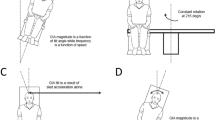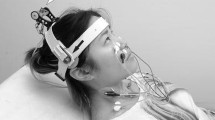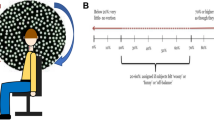Abstract
The possibility of synergistic interaction between the canal and otolith components of the horizontal vestibulo-ocular reflex (VOR) was evaluated in human subjects by subtracting the response to pure angular rotation (AVOR) from the response to combined angular and translational motion (ALVOR) and comparing this difference with the VOR to isolated linear motion (LVOR). Assessments were made with target fixation at 60 cm and in darkness. Linear stimuli were acceleration steps attaining 0.25 g in less than 80 ms. To elicit responses to combined translational and angular head movements, the subjects were seated on a Barany chair with the head displaced forwards 40 cm from the axis of rotation. The chair was accelerated at approximately 300 deg/s2 to 127 deg/s peak angular velocity, the tangential acceleration of the head being comparable with that of isolated translation. Estimates of the contribution of smooth pursuit to responses in the light were made from comparisons of isolated pursuit of similar target trajectories. In the dark the slow phase eye movements evoked by combined canal-otolith stimuli were higher in magnitude by approximately a third than the sum of those produced by translation and rotation alone. In the light, the relative target displacement during isolated linear motion was similar to the difference in relative target displacements during eccentric and centred rotation. However, the gain of the translational component of compensatory eye movement during combined translational and angular motion was approximately unity, in contrast to the gain of the response to isolated linear motion, which was approximately a half. Pursuit performance was always poorer than target following during self-motion. The LVOR responses in the light were greater than the sum of the LVOR responses in the dark with pursuit eye movements. We conclude that, in response to transient motion, there is a synergistic enhancement of the translational VOR with concurrent canal stimulation and that the enhancement of the LVOR in the light is not due solely to pursuit.
Similar content being viewed by others
References
Angelaki DE, Anderson JH (1991) The vestibulo-ocular reflex in the cat during linear acceleration in the sagittal plane. Brain Res 543: 347–350
Baloh RW, Beykirch K, Honrubia V, Yee RD (1988) Eye movements induced by linear acceleration on a parallel swing. J Neurophysiol 60: 2000–2013
Bronstein AM, Gresty MA (1988) Short latency compensatory eye movement responses to transient linear head acceleration: a specific function of the otolith-ocular reflex. Exp Brain Res 71: 406–410
Buizza A, Leger A, Droulez J, Berthoz A, Schmid R (1980) Influence of otolithic stimulation by horizontal linear acceleration on optokinetic nystagmus and visual motion perception. Exp Brain Res 39: 165–176
Fernandez C, Goldberg JM (1976) Physiology of peripheral neurons innervating otolith organs in the squirrel monkey. J Neurophysiol 39: 970–1008
Gauthier GM, Vercher JL (1990) Visual vestibular interaction: vestibulo-ocular reflex suppression with head-fixed target fixation. Exp Brain Res 81: 150–160
Gresty MA (1973) The relationship between head and eye movements. Agressologie 14: 7–10
Gresty MA, Bronstein AM (1986) Otolith stimulation evokes compensatory reflex eye movements of high velocity when linear motion of the head is combined with concurrent angular motion. Neurosci Lett 65: 149–154
Gresty MA, Bronstein AM, Barratt H (1987) Eye movement responses to combined linear and angular head movement. Exp Brain Res 65: 377–384
Lichtenberg BK, Young LR, Arrott AP (1982) Human ocular counterrolling induced by varying linear accelerations. Exp Brain Res 48: 127–136
Niven JI, Hixson WC, Correia MJ (1966) Elicitation of horizontal nystagmus by periodic linear acceleration. Acta Otolaryngol (Stockh) 62: 429–441
Paige GD (1989) The influence of target distance on eye movement responses during vertical linear motion. Exp Brain Res 77:-585–593
Sargent EW, Paige GD (1991) The primate vestibulo-ocular reflex during combined linear and angular head motion. Exp Brain Res 87: 75–84
Schwarz U, Busettinni C, Miles FA (1989) Ocular responses to linear motion are inversely proportional to viewing distance. Science 245: 1394–1396
Shelhamer M, Young LR (1991) Linear acceleration and horizontal eye movements in man. Acta Otolaryngol (Stockh) Suppl 481: 277–281
Skipper JJ, Barnes GR (1989) Eye movements induced by linear acceleration are modified by visualization of imaginary targets. Acta Otolaryngol (Stockh) Suppl 468: 289–293
Smith R (1985) Vergence eye-movement responses to whole-body linear acceleration stimuli in man. Ophthalmic Physiol Opt 5: 303–311
Snyder LH, King WM (1992) Effect of viewing distance and location of the axis of head rotation on the monkey's vestibuloocular reflex. I. Eye movement responses. J Neurophysiol 67: 861–874
Tokita T, Miyata H, Masaki M, Ikeda S (1991) Dynamic characteristics of the otolithic oculomotor system. Ann NY Acad Sci 374: 56–69
Viirre E, Tweed D, Milner K, Vilis T (1986) A reexamination of the gain of the vestibuloocular reflex. J Neurophysiol 56: 439–450
Young LR (1972) Cross coupling between effects of linear and angular acceleration on vestibular nystagmus. Bibl Ophthalmol 82: 116–121
Author information
Authors and Affiliations
Rights and permissions
About this article
Cite this article
Anastasopoulos, D., Gianna, C.C., Bronstein, A.M. et al. Interaction of linear and angular vestibulo-ocular reflexes of human subjects in response to transient motion. Exp Brain Res 110, 465–472 (1996). https://doi.org/10.1007/BF00229146
Received:
Accepted:
Issue Date:
DOI: https://doi.org/10.1007/BF00229146




